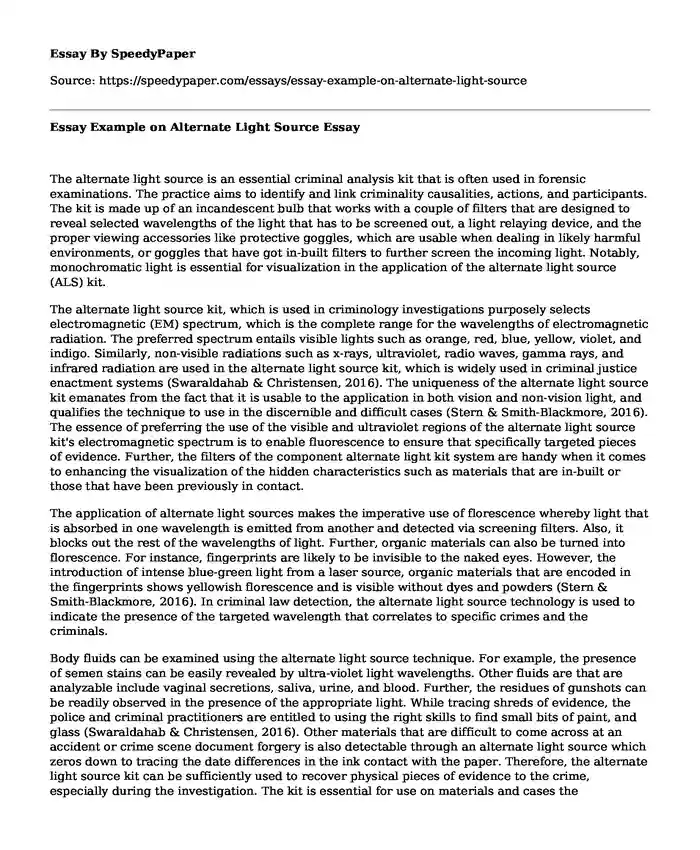
| Type of paper: | Essay |
| Categories: | Analysis Forensic science |
| Pages: | 3 |
| Wordcount: | 671 words |
The alternate light source is an essential criminal analysis kit that is often used in forensic examinations. The practice aims to identify and link criminality causalities, actions, and participants. The kit is made up of an incandescent bulb that works with a couple of filters that are designed to reveal selected wavelengths of the light that has to be screened out, a light relaying device, and the proper viewing accessories like protective goggles, which are usable when dealing in likely harmful environments, or goggles that have got in-built filters to further screen the incoming light. Notably, monochromatic light is essential for visualization in the application of the alternate light source (ALS) kit.
The alternate light source kit, which is used in criminology investigations purposely selects electromagnetic (EM) spectrum, which is the complete range for the wavelengths of electromagnetic radiation. The preferred spectrum entails visible lights such as orange, red, blue, yellow, violet, and indigo. Similarly, non-visible radiations such as x-rays, ultraviolet, radio waves, gamma rays, and infrared radiation are used in the alternate light source kit, which is widely used in criminal justice enactment systems (Swaraldahab & Christensen, 2016). The uniqueness of the alternate light source kit emanates from the fact that it is usable to the application in both vision and non-vision light, and qualifies the technique to use in the discernible and difficult cases (Stern & Smith-Blackmore, 2016). The essence of preferring the use of the visible and ultraviolet regions of the alternate light source kit's electromagnetic spectrum is to enable fluorescence to ensure that specifically targeted pieces of evidence. Further, the filters of the component alternate light kit system are handy when it comes to enhancing the visualization of the hidden characteristics such as materials that are in-built or those that have been previously in contact.
The application of alternate light sources makes the imperative use of florescence whereby light that is absorbed in one wavelength is emitted from another and detected via screening filters. Also, it blocks out the rest of the wavelengths of light. Further, organic materials can also be turned into florescence. For instance, fingerprints are likely to be invisible to the naked eyes. However, the introduction of intense blue-green light from a laser source, organic materials that are encoded in the fingerprints shows yellowish florescence and is visible without dyes and powders (Stern & Smith-Blackmore, 2016). In criminal law detection, the alternate light source technology is used to indicate the presence of the targeted wavelength that correlates to specific crimes and the criminals.
Body fluids can be examined using the alternate light source technique. For example, the presence of semen stains can be easily revealed by ultra-violet light wavelengths. Other fluids are that are analyzable include vaginal secretions, saliva, urine, and blood. Further, the residues of gunshots can be readily observed in the presence of the appropriate light. While tracing shreds of evidence, the police and criminal practitioners are entitled to using the right skills to find small bits of paint, and glass (Swaraldahab & Christensen, 2016). Other materials that are difficult to come across at an accident or crime scene document forgery is also detectable through an alternate light source which zeros down to tracing the date differences in the ink contact with the paper. Therefore, the alternate light source kit can be sufficiently used to recover physical pieces of evidence to the crime, especially during the investigation. The kit is essential for use on materials and cases the conventional light is unable to reveal the required information. For instance, conventional light sources are dependent on the composition materials used such that evidence the contact could hardly be revealed.
References
Stern, A. W., & Smith-Blackmore, M. (2016). Veterinary forensic pathology of animal sexual abuse. Veterinary pathology, 53(5), 1057-1066. Retrieved from: https://journals.sagepub.com/doi/pdf/10.1177/0300985816643574
Swaraldahab, M. A., & Christensen, A. M. (2016). The effect of time on bone fluorescence: implications for using alternate light sources to search for skeletal remains. Journal of forensic sciences, 61(2), 442-444. Retrieved from: http://www.academia.edu/download/46291261/Swaraldahab_and_Christensen_2016_JFS_ALS.pdf
Cite this page
Essay Example on Alternate Light Source. (2022, Dec 21). Retrieved from https://speedypaper.net/essays/essay-example-on-alternate-light-source
Request Removal
If you are the original author of this essay and no longer wish to have it published on the SpeedyPaper website, please click below to request its removal:
- Black Power Movement - Free Essay in American History
- Marketing Essay Sample on The Coca-Cola Company and Diet Coke
- Free Essay Sample - Interview Reflection
- Free Essay: New Harvest Coffee Roasters Brews Up Fresh Business
- Use of Biometrics and Cryptography in Computer Security - Essay Sample
- Free Essay: Is Healthcare a Right or a Privilege?
- Free Essay on Decoding Student Choices: AP Math vs. Science Selections
Popular categories




